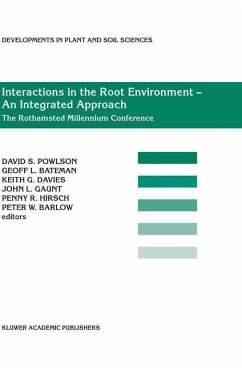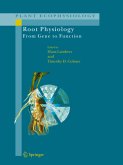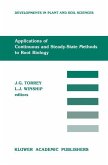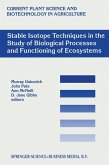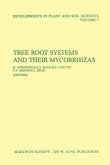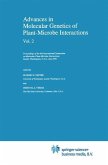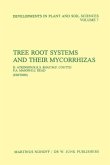PowlsonProceedings of the Millenium Conference on Rhizosphere Interactions, IACR-Rothamsted, United Kingdom 10- April, 2001
Interactions in the Root Environment - An Integrated Approach
Proceedings of the Millenium Conference on Rhizosphere Interactions, IACR-Rothamsted, United Kingdom 10- April, 2001
Herausgegeben:Powlson, David S.; Bateman, Geoff L.; Davies, Keith G.; Gaunt, John L.; Hirsch, Penny R.; Barlow, Peter W.
PowlsonProceedings of the Millenium Conference on Rhizosphere Interactions, IACR-Rothamsted, United Kingdom 10- April, 2001
Interactions in the Root Environment - An Integrated Approach
Proceedings of the Millenium Conference on Rhizosphere Interactions, IACR-Rothamsted, United Kingdom 10- April, 2001
Herausgegeben:Powlson, David S.; Bateman, Geoff L.; Davies, Keith G.; Gaunt, John L.; Hirsch, Penny R.; Barlow, Peter W.
- Gebundenes Buch
- Merkliste
- Auf die Merkliste
- Bewerten Bewerten
- Teilen
- Produkt teilen
- Produkterinnerung
- Produkterinnerung
This volume contains a selection of papers presented at the Rothamsted Millennium Conference "Interactions in the Root Environment - an Integrated Approach". The meeting brought together scientists from a range of disciplines interested in the relationship between soil biology and plant growth, reflected by the contents of the volume. Topics range from root development and nutrient flow, plant-microbe and plant-plant signaling, methods for studying bacterial and fungal diversity, to the exploitation of rhizosphere interactions for biological control of diseases and soil remediation. Authors…mehr
Andere Kunden interessierten sich auch für
![Root Physiology: from Gene to Function Root Physiology: from Gene to Function]() Root Physiology: from Gene to Function112,99 €
Root Physiology: from Gene to Function112,99 €![Arbuscular Mycorrhizas Arbuscular Mycorrhizas]() Y. Kapulnik / David D. Douds Jr. (Hgg.)Arbuscular Mycorrhizas115,99 €
Y. Kapulnik / David D. Douds Jr. (Hgg.)Arbuscular Mycorrhizas115,99 €![Applications of Continuous and Steady-State Methods to Root Biology Applications of Continuous and Steady-State Methods to Root Biology]() John G. Torrey / Lawrence J. Winship (Hgg.)Applications of Continuous and Steady-State Methods to Root Biology115,99 €
John G. Torrey / Lawrence J. Winship (Hgg.)Applications of Continuous and Steady-State Methods to Root Biology115,99 €![Stable Isotope Techniques in the Study of Biological Processes and Functioning of Ecosystems Stable Isotope Techniques in the Study of Biological Processes and Functioning of Ecosystems]() M.J. Unkovich / J.S. Pate / A. McNeill / J. Gibbs (Hgg.)Stable Isotope Techniques in the Study of Biological Processes and Functioning of Ecosystems115,99 €
M.J. Unkovich / J.S. Pate / A. McNeill / J. Gibbs (Hgg.)Stable Isotope Techniques in the Study of Biological Processes and Functioning of Ecosystems115,99 €![Tree Root Systems and Their Mycorrhizas Tree Root Systems and Their Mycorrhizas]() Tree Root Systems and Their Mycorrhizas153,99 €
Tree Root Systems and Their Mycorrhizas153,99 €![Advances in Molecular Genetics of Plant-Microbe Interactions, Vol. 2 Advances in Molecular Genetics of Plant-Microbe Interactions, Vol. 2]() E.W. Nester / D.P.S Verma (Hgg.)Advances in Molecular Genetics of Plant-Microbe Interactions, Vol. 2154,99 €
E.W. Nester / D.P.S Verma (Hgg.)Advances in Molecular Genetics of Plant-Microbe Interactions, Vol. 2154,99 €![Tree Root Systems and Their Mycorrhizas Tree Root Systems and Their Mycorrhizas]() D. Atkinson / K.K.S. Bhat / M.P. Coutts / P.A. Mason / D.K. Read (eds.)Tree Root Systems and Their Mycorrhizas153,99 €
D. Atkinson / K.K.S. Bhat / M.P. Coutts / P.A. Mason / D.K. Read (eds.)Tree Root Systems and Their Mycorrhizas153,99 €-
-
-
This volume contains a selection of papers presented at the Rothamsted Millennium Conference "Interactions in the Root Environment - an Integrated Approach". The meeting brought together scientists from a range of disciplines interested in the relationship between soil biology and plant growth, reflected by the contents of the volume. Topics range from root development and nutrient flow, plant-microbe and plant-plant signaling, methods for studying bacterial and fungal diversity, to the exploitation of rhizosphere interactions for biological control of diseases and soil remediation. Authors include many internationally-recognized experts in their field and the contributions range from reviews to research papers. The volume presents a timely and wide-ranging overview of the interactions between plants, microbes and soil. It should prove an indispensable resource for students and others seeking an introduction to the topic, in addition to scientists already conversant with the areaof research.
Produktdetails
- Produktdetails
- Developments in Plant and Soil Sciences 96
- Verlag: Springer / Springer Netherlands
- Artikelnr. des Verlages: 978-1-4020-0740-8
- Reprinted from PLANT AND SOIL, 232:1-2, 2002
- Seitenzahl: 236
- Erscheinungstermin: 31. August 2002
- Englisch
- Abmessung: 266mm x 200mm x 18mm
- Gewicht: 723g
- ISBN-13: 9781402007408
- ISBN-10: 140200740X
- Artikelnr.: 20954878
- Herstellerkennzeichnung Die Herstellerinformationen sind derzeit nicht verfügbar.
- Developments in Plant and Soil Sciences 96
- Verlag: Springer / Springer Netherlands
- Artikelnr. des Verlages: 978-1-4020-0740-8
- Reprinted from PLANT AND SOIL, 232:1-2, 2002
- Seitenzahl: 236
- Erscheinungstermin: 31. August 2002
- Englisch
- Abmessung: 266mm x 200mm x 18mm
- Gewicht: 723g
- ISBN-13: 9781402007408
- ISBN-10: 140200740X
- Artikelnr.: 20954878
- Herstellerkennzeichnung Die Herstellerinformationen sind derzeit nicht verfügbar.
Section 1. Signalling and recognition in the root environment.- 1. Analysis of N-acyl homoserine-lactone quorum-sensing molecules made by different strains and biovars of Rhizobium leguminosarum containing different symbiotic plasmids.- 2. Signalling between arbuscular mycorrhizal fungi and plants: identification of a gene expressed during early interactions by differential RNA display analysis.- 3. Methods for studying the nematophagous fungus Verticillium chlamydosporium in the root environment.- 4. Does allelopathy offer real promise for practical weed management and for explaining rhizosphere interactions involving higher plants?.- Section 2. Root structure and function.- 5. Root proliferation, nitrate inflow and their carbon costs during nitrogen capture by competing plants in patchy soil.- 6. The nutritional control of root development.- 7. Effect of phosphorus availability on basal root shallowness in common bean.- 8. A comparison of structure, development and function in cluster roots of Lupinus albus L. under phosphate and iron stress.- Section 3. Biologically-mediated processes in the root environment.- 9. Rhizosphere carbon flow measurement and implications: from isotopes to reporter genes.- 10. Soil and rhizosphere as habitats for Pseudomonas inoculants: new knowledge on distribution, activity and physiological state derived from micro-scale and single-cell studies.- 11. Sulphur and phosphorus transport systems in plants.- 12. Incorporating rhizosphere processes into field-scale (agro)ecosystem models.- 13. Plant-mediated processess to acquire nutrients: nitrogen uptake by rice plants.- Section 4. Biodiversity in the root environment.- 14. Plants and fertilisers as drivers of change in microbial community structure and function in soils.- 15. Soil fungi: diversity and detection.- 16. On the relationships between nematodes, mycorrhizal fungi and plants: functional composition of species and plant performance.- 17. Bacterial diversity of the rhizosphere of maize (Zea mays) grown in tropical soil studied by temperature gradient gel electrophoresis.- 18. Monitoring temporal and spatial variation in rhizosphere bacterial population diversity: A community approach for the improved selection of rhizosphere competent bacteria.- Section 5. Exploitation of rhizosphere interactions.- 19. Enhancing the biocontrol efficacy of Pseudomonas fluorescens Fl 13 by altering the regulation and production of 2,4-diacetylphloroglucinol.- 20. Plant and rhizosphere processes involved in phytoremediation of metal-contaminated soils.- 21. An integrated approach for the evaluation of biological control of the complex Polymyxa betae/Beet Necrotic Yellow Vein Virus, by means of seed inoculants.
Section 1. Signalling and recognition in the root environment.- 1. Analysis of N-acyl homoserine-lactone quorum-sensing molecules made by different strains and biovars of Rhizobium leguminosarum containing different symbiotic plasmids.- 2. Signalling between arbuscular mycorrhizal fungi and plants: identification of a gene expressed during early interactions by differential RNA display analysis.- 3. Methods for studying the nematophagous fungus Verticillium chlamydosporium in the root environment.- 4. Does allelopathy offer real promise for practical weed management and for explaining rhizosphere interactions involving higher plants?.- Section 2. Root structure and function.- 5. Root proliferation, nitrate inflow and their carbon costs during nitrogen capture by competing plants in patchy soil.- 6. The nutritional control of root development.- 7. Effect of phosphorus availability on basal root shallowness in common bean.- 8. A comparison of structure, development and function in cluster roots of Lupinus albus L. under phosphate and iron stress.- Section 3. Biologically-mediated processes in the root environment.- 9. Rhizosphere carbon flow measurement and implications: from isotopes to reporter genes.- 10. Soil and rhizosphere as habitats for Pseudomonas inoculants: new knowledge on distribution, activity and physiological state derived from micro-scale and single-cell studies.- 11. Sulphur and phosphorus transport systems in plants.- 12. Incorporating rhizosphere processes into field-scale (agro)ecosystem models.- 13. Plant-mediated processess to acquire nutrients: nitrogen uptake by rice plants.- Section 4. Biodiversity in the root environment.- 14. Plants and fertilisers as drivers of change in microbial community structure and function in soils.- 15. Soil fungi: diversity and detection.- 16. On the relationships between nematodes, mycorrhizal fungi and plants: functional composition of species and plant performance.- 17. Bacterial diversity of the rhizosphere of maize (Zea mays) grown in tropical soil studied by temperature gradient gel electrophoresis.- 18. Monitoring temporal and spatial variation in rhizosphere bacterial population diversity: A community approach for the improved selection of rhizosphere competent bacteria.- Section 5. Exploitation of rhizosphere interactions.- 19. Enhancing the biocontrol efficacy of Pseudomonas fluorescens Fl 13 by altering the regulation and production of 2,4-diacetylphloroglucinol.- 20. Plant and rhizosphere processes involved in phytoremediation of metal-contaminated soils.- 21. An integrated approach for the evaluation of biological control of the complex Polymyxa betae/Beet Necrotic Yellow Vein Virus, by means of seed inoculants.

